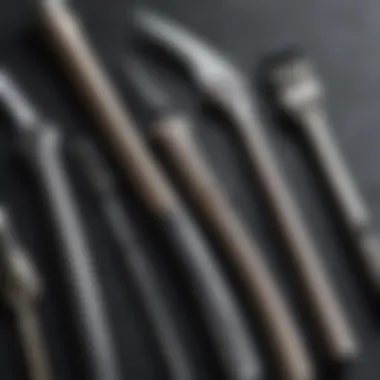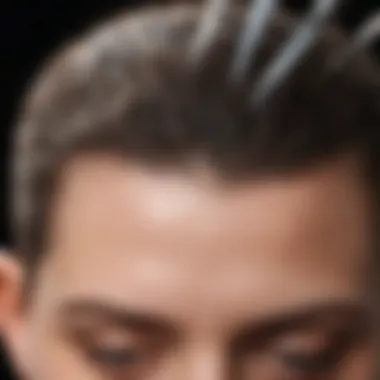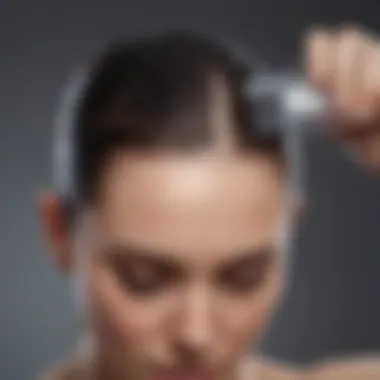Comprehensive Guide to Scalp Scraping Tools


Intro
In recent years, scalp scraping has gained significant attention as an effective method for improving scalp health and promoting hair growth. This guide aims to provide a thorough understanding of scalp scraping tools, their benefits, and how to effectively incorporate them into your hair care routine. By understanding the principles behind these tools, readers can make informed choices that positively impact their hair health.
Scalp scraping tools vary in design and function, making it essential to identify which type will best suit your individual needs. Additionally, it is crucial to understand the science that backs these practices, as well as any potential risks. Each section will explore different aspects of scalp scraping, equipping readers with knowledge necessary for making the best choices for their hair and scalp.
By the end of this article, hair care enthusiasts will have a comprehensive understanding of the current landscape of scalp scraping tools and their role in holistic hair care. Let’s delve into the specifics that make these tools vital for modern beauty and wellness routines.
Prologue to Scalp Scraping
Scalp scraping is gaining attention in the realm of personal care, and this section seeks to highlight its significance in contemporary beauty regimes. Understanding the essence of scalp scraping enables individuals to appreciate its multifaceted benefits for both scalp and hair health. As a technique that combines elements of both physical care and self-treatment, it plays a pivotal role in promoting good hygiene and wellness. This article will delineate various aspects of scalp scraping, emphasizing its advantages and considerations.
Definition of Scalp Scraping
Scalp scraping is the practice of using specialized tools to exfoliate the scalp's outer layer. This is done to remove dead skin cells, excess oil, and product buildup that can accumulate over time. The procedure is often performed using manual or electric tools designed for such a purpose. The fundamental aim of scalp scraping is to cleanse the scalp, which can lead to healthier hair follicles and an overall enhancement of scalp health. Exfoliating the scalp can stimulate circulation and promote a more nourishing environment for hair growth.
Historical Context
The origins of scalp scraping can be traced back to ancient beauty rituals, where individuals employed various tools to maintain scalp and hair health. Historical documents suggest that this practice was widely recognized in different cultures, whether through the use of stones, manual tools, or even primitive devices made from natural materials. There are references pointing to its use in traditional Chinese medicine, where methods similar to scraping were believed to balance the body's energetics. This practice has evolved over centuries, adapting to advances in materials and techniques. In more recent years, there has been a resurgence in its popularity, particularly influenced by the holistic self-care trend that emphasizes nurturing both the body and mind.
Types of Scalp Scraping Tools
Understanding the various types of scalp scraping tools is essential for effectively incorporating this practice into one’s hair care regimen. The type of tool can significantly influence the experience and the results of scalp scraping. Each tool has its unique characteristics, providing benefits depending on individual needs and preferences. This section will explore manual and electric tools, along with their material compositions.
Manual Tools
Manual scalp scraping tools are often favored for their simplicity and control during use. Common varieties include metal massage combs and wooden scrapers. These tools require no power source, making them portable and easy to use at any time. Manual tools allow for a personalized approach, letting users adjust pressure and technique to suit their comfort level. Moreover, they encourage intentionality, as one has to engage fully during the scrapping process. However, they may require more effort compared to electric alternatives.
Electric Tools
Electric scalp scrapers often come with built-in features designed to enhance effectiveness and ease of use. They typically provide vibrations or gentle massage functions, which are beneficial for stimulating the scalp. Many users find these tools to be more efficient for larger areas as compared with manual tools. Electric versions might also include temperature control, which can further improve circulation. However, they may be costlier and require access to power or batteries, which can limit their convenience.
Material Composition
Different materials can influence the functionality and effectiveness of scalp scraping tools. The most common materials include metal, plastic, and wood, each with their advantages and disadvantages. Understanding the composition helps users make informed choices, allowing for tailored experiences to suit individual scalp health needs.
Metal
Metal tools are a popular choice due to their durability and effectiveness. Typically crafted from stainless steel, they provide a smooth surface that glides easily across the scalp. The key characteristic of metal is its ability to apply consistent pressure without warping or bending. However, one must be cautious as metal tools can sometimes feel harsh on sensitive scalps.
Plastic
Plastic scalp scrapers are generally lighter and more flexible than their metal counterparts. They tend to be gentler, which makes them a suitable option for individuals with delicate skin or scalp issues. Many plastic options are available in various colors and designs, adding an aesthetic appeal. However, plastic may not provide the same longevity or effectiveness as metal, especially with frequent use.


Wood
Wooden scalp scraping tools have gained popularity due to their natural properties. They are believed to offer a softer touch, often providing a calming experience. A key feature of wood is its eco-friendliness, appealing to those interested in sustainable products. Additionally, wood can enhance the aesthetic of one’s personal care toolkit. On the downside, wooden tools may require more maintenance to ensure they don’t absorb moisture or harbor bacteria.
Each material has its strengths and weaknesses, so choosing the right tool is about aligning it with one's specific needs and preferences.
Benefits of Scalp Scraping
Understanding the benefits of scalp scraping is crucial for anyone seeking to enhance their scalp health and overall hair quality. Many people often overlook the importance of their scalp, thinking only about their hair strands. However, taking care of the scalp is equally important. Scalp scraping offers several benefits that can significantly impact hair growth and scalp condition. By including regular scalp scraping in one’s hair care routine, individuals can achieve healthier hair and improved scalp vitality.
Exfoliation
Exfoliation is a primary benefit of scalp scraping. This process removes dead skin cells and excess sebum that can accumulate on the scalp. Regular exfoliation helps to unclog hair follicles, which can promote healthier hair growth. When the scalp is free of debris, it allows for optimal airflow and reduces the risk of microbial growth that may lead to issues like dandruff or scalp inflammation.
Many people might question how often they should exfoliate. It is often recommended to incorporate scalp scraping into one's regimen one to two times per week, depending on scalp oiliness. Using a tool specifically designed for scalp scraping ensures that the exfoliation is effective without causing irritation. This way, the scalp remains balanced and healthy, setting a solid foundation for hair care.
Improved Blood Circulation
Scalp scraping encourages improved blood circulation, which is vital for healthy hair growth. Increased blood flow to the scalp delivers essential nutrients and oxygen to hair follicles. This stimulated circulation can boost hair growth by ensuring that hair follicles receive adequate nourishment. Enhanced blood circulation also plays a role in reducing hair thinning.
When using a scalp scraping tool, the method of application matters. Gentle pressure and sweeping motions can activate blood flow without causing trauma to the scalp. This approach not only promotes scalp health but also contributes to relaxation. Some tools even incorporate added features, like vibrations, aimed at enhancing the overall experience while promoting better blood circulation.
Enhanced Product Absorption
The effectiveness of hair products is often tied to how well they absorb into the scalp and hair. Scalp scraping can enhance product absorption by creating a cleaner, exfoliated surface. When the scalp is free of dead skin and buildup, topical products can penetrate more effectively. This results in better uptake of ingredients designed to nourish and treat the scalp and hair, thus maximizing the benefits of products like serums and conditioners.
For individuals using growth serums or topical treatments, using a scalp scraping tool beforehand can yield significantly better results. When applied to a freshly scraped scalp, these products are more likely to deliver their key ingredients effectively, leading to enhanced results over time. A consistent routine integrating scalp scraping can ultimately improve one’s overall hair care regimen, ensuring the benefits of quality products are not wasted.
"A clean scalp is the foundation of healthy hair."
Importantly, pay attention to how your scalp responds to regular scraping and adjust your routine accordingly. Maintaining balance is essential; over-scraping can lead to irritations or sensitivity. Always observe your scalp's unique needs.
How to Use a Scalp Scraping Tool
Understanding how to properly use a scalp scraping tool is critical for achieving optimal results. The right technique enhances the benefits of scalp scraping, leading to improved scalp health and overall hair quality. With the correct approach, one can maximize good outcomes while minimizing the risk of irritation or other adverse effects. Here, we will break down the key elements involved in using a scalp scraping tool into comprehensive preparation steps, technique and application, and frequency of use.
Preparation Steps
Preparation is key before engaging in scalp scraping. It establishes the right conditions for the scraping process and helps avoid any possible reactions.
- Choose the Right Tool: Select a scalp scraping tool appropriate for your needs. Consider factors like material, handle design, and your comfort level while using it.
- Clean the Tool: Disinfect the scalp scraper with alcohol or warm, soapy water to minimize the risk of scalp irritation or infections.
- Prepare Your Scalp: Ensure that your hair is clean and dry. Some individuals prefer to scrape on damp hair, while others find it's best done on dry hair. Experiment to see what works best for you.
- Apply a Pre-Treatment: Consider applying a lightweight oil or serum to your scalp. This can help in easing the scraping process and provide additional scalp nourishment.
Technique and Application
Once prepared, it is essential to use the right technique when scraping the scalp. Mindfulness during this process enhances the overall experience and results.
- Hold the Tool at an Angle: Position the tool at a slight angle against your scalp instead of scraping directly. This technique helps to avoid irritation and allows for more effective scraping.
- Use Gentle Pressure: Apply firm yet gentle pressure. Too much force may lead to discomfort or injury. Focus on a comfortable sensation while scraping.
- Move in Sections: Start at the back of your head and move in sections towards the front. Sections allow for thorough scraping, ensuring no area is neglected.
- Follow Up on Areas: Pay attention to areas that feel tense or have product buildup. Spend extra time gently scraping these spots for thorough cleansing.
- Finalize the Process: After scraping for about five to ten minutes, stop and assess your scalp. Normal redness is expected, but anything beyond that should be treated with care.


Frequency of Use
The frequency of using a scalp scraping tool varies based on individual scalp conditions and preferences. It is important to listen to your scalp and adjust accordingly.
- Once a Week: A good starting point for most people, especially if new to scalp scraping.
- Twice a Month: For those with sensitive scalps or existing scalp conditions, this might be preferable.
- As Needed: If experiencing product buildup or changes in scalp health, use the tool as required, but ensure to take breaks between sessions.
Regular use of a scalp scraping tool leads to better scalp health, improves blood circulation, and enhances the effects of topical treatments.
In summary, proper preparation, technique, and frequency contribute to the effectiveness of scalp scraping tools. Suitable attention to these factors can yield significant results without compromising scalp integrity.
Potential Risks and Considerations
Understanding the potential risks and considerations related to scalp scraping is crucial for anyone interested in incorporating these tools into their hair care routine. While scalp scraping offers various benefits, awareness of possible side effects can enhance safety and efficacy. Here, we will discuss the main points about skin sensitivity, existing scalp conditions, and contraindications.
Skin Sensitivity
Scalp sensitivity is a significant aspect to consider. Some individuals have skin that reacts strongly to new treatments. Scalp scraping can cause irritation, especially for those with sensitive skin types.
It is advisable to conduct a patch test before regular use. This involves testing the scraping tool on a small area of the scalp to observe any adverse reactions. Redness, bumps, or unusual discomfort may indicate that scalp scraping is not suitable for you. If irritation occurs, it is best to stop use and consult a dermatologist.
Underlying Scalp Conditions
Individuals with pre-existing scalp conditions such as psoriasis, eczema, or fungal infections should exercise caution when considering scalp scraping. These conditions can be aggravated by mechanical stimulation, leading to discomfort and worsening of symptoms.
For those with chronic issues, it might be necessary to consult a healthcare professional before starting any scalp scraping regimen. They can provide tailored advice based on individual health circumstances. This approach minimizes the risk of exacerbating any underlying conditions.
Contraindications
Certain contraindications should also be taken into account to ensure safe use of scalp scraping tools. If you have recently undergone any scalp treatments, such as chemical peels, microdermabrasion, or laser therapy, it is essential to refrain from using scraping tools until you have fully healed. Engaging in scalp scraping too soon may cause painful complications or harm.
Post-Treatment Care
Post-treatment care is a crucial aspect of maintaining scalp health after using a scalp scraping tool. The scalp is sensitive, and the treatment can leave it vulnerable. Proper aftercare promotes healing, prevents irritation, and ensures the benefits of the session are maximized.
Recommended Products
Selecting the right post-treatment products can make a significant impact on the scalp's recovery. Look for soothing lotions and serums that contain ingredients like aloe vera, which provides hydration and reduces redness. Also, consider products formulated with chamomile or calendula, as these are known for their calming properties. Essential oils like tea tree or lavender can help with inflammation and promote a healthy scalp environment. Here are some product suggestions:
- Moisturizing Scalp Lotion
- Calming Serum with Aloe Vera
- Tea Tree Oil for Anti-Inflammatory Benefits
Always patch test new products to ensure they do not cause further irritation.
Signs of Irritation to Watch


After using a scalp scraping tool, it is important to monitor the scalp for signs of irritation. Common symptoms include:
- Redness in the treated areas
- Itching or a tingling sensation
- Dry patches that may form over time
If any of these appear, it may indicate that the scalp is reacting to the treatment. It is advisable to stop using the tool and consult a dermatologist if the symptoms persist or worsen. Prioritizing the scalp's health is essential for long-term beauty routines.
Long-term Maintenance
To sustain scalp health, incorporating long-term maintenance strategies is vital. This may involve regular scalp scrapes, but the frequency should be adjusted based on individual sensitivity and skin type. Additionally, integrating nourishing practices, such as scalp massages and using good quality hair care products, can help sustain scalp vitality.
Routine Suggestions:
- Schedule scalp scraping sessions every 2-4 weeks, depending on scalp condition.
- Maintain a balanced diet rich in vitamins and omega fatty acids for overall hair health.
- Stay hydrated, as proper hydration supports skin health.
By paying attention to post-treatment care, users can enhance their overall hair health journey, ensuring that the benefits from scalp scraping are long-lasting.
Emerging Trends in Scalp Care
In recent years, interest in scalp health has surged, leading to innovative practices and tools in hair care. Emerging trends in scalp care focus on enhancing overall scalp condition, fostering hair growth, and incorporating advanced techniques. Understanding these trends is essential, as they contribute to maintaining a healthy scalp and hair. The focus on scalp care is becoming crucial not just from a cosmetic point of view but also as part of holistic health practices.
Influence of Technology
The integration of technology into scalp care is reshaping how individuals interact with their hair health. Advanced tools, such as electric scalp scrubbers and ultrasonic scalp massagers, provide a more effective approach to scalp scraping. These devices often come equipped with sensors that detect scalp conditions and optimize treatment methods.
Here are some notable technological advancements:
- Smart Scalp Devices: Some devices now have smart features that provide real-time feedback on scalp health.
- Scalp Analysis Apps: These applications analyze scalp conditions before suggesting appropriate tools or treatments.
- High-Frequency Tools: Some newer products utilize high-frequency vibrations to enhance blood circulation and promote scalp rejuvenation.
The adoption of such technologies allows consumers to achieve a more precise and personalized approach to their scalp care. It also fosters a deeper understanding of individual hair and scalp needs.
Holistic Approaches
Holistic approaches to scalp care emphasize the connection between the body and the mind. This perspective views scalp health as part of an overall wellness routine. Incorporating natural ingredients, such as essential oils and herbal extracts, can complement traditional scalp scraping tools.
Some key holistic approaches include:
- Essential Oils: Rosemary and tea tree oils are popular choices believed to enhance scalp health.
- Nutritional Considerations: A balanced diet rich in vitamins and omega-3 fatty acids supports scalp and hair vitality.
- Mindfulness Practices: Techniques like meditation can help reduce stress, which may positively impact hair health.
"Taking care of the scalp is not just about external products; it is also about internal well-being."
The blend of traditional practices and modern insights leads to a more comprehensive approach to scalp care. With nature and science working together, individuals can explore more effective and enriching ways to maintain their scalp health.
Final Thoughts
In examining scalp scraping tools, the significance of understanding how they relate to overall scalp health becomes evident. They represent a blend of traditional methods and modern advancements in beauty care. The discussion on scalp scraping is not merely about tools; it extends into the realm of self-care and routine health practices that can substantially influence hair vitality and scalp wellbeing.
Future of Scalp Health
As we envision the future of scalp health, several factors stand out that may shape its trajectory.
- Technological Integration: The beauty and wellness industries continue to intertwine with technology. Wearable devices and apps that monitor scalp condition can soon become common, guiding users in their routines. This data-driven approach may allow for more personalized healthcare regimens that cater to individual needs.
- Scientific Research: Ongoing studies into the scalp microbiome are paving the way for innovative products that target specific issues, fostering a deeper understanding of how the scalp interacts with various elements, such as environmental factors, diet, and lifestyle habits.
- Sustainability: Consumers are increasingly mindful of the sustainability of beauty products. Future scalp scraping tools may emphasize eco-friendly materials and ethical practices in manufacturing.
- Holistic Approaches: There is a noticeable shift toward holistic health approaches. Scalp care is likely to be integrated more with general wellness practices, considering aspects like nutrition and stress management, which contribute to scalp conditions.















